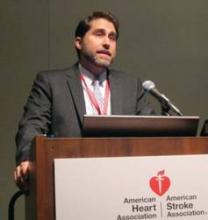HONOLULU – Almost one-fifth of patients who underwent aortic valve surgery experienced a stroke in a prospective, cohort study of 196 patients.
"Stroke is a very prevalent complication of aortic valve replacement, and it’s much more common than prior series have suggested," Dr. Steven Messé said at the International Stroke Conference.
Based on the literature, the risk of periprocedural stroke varies widely from a low of less than 1% to 9% for cardiac valve replacement and 10% for heart transplant and left ventricular assist device placement, he said. If the number of times these procedures are performed each year is added to the equation, cardiac procedures account for about 5% of strokes annually in the United States.
"Unfortunately, the reality is probably worse than the literature," Dr. Messé said.
He observed that most risk estimates come from trials and case series rather than clinical practice, and that the vast majority of these studies did not include systematic evaluation by neurologists, who tend to be more sensitive to subtle yet meaningful deficits. Recent evidence also suggests that ischemic neurologic complications following surgery are increasing, "possibly related to the willingness of surgeons to undertake procedures with higher-risk patients," said Dr. Messé, a neurologist at the Hospital of the University of Pennsylvania, Philadelphia. To access their own stroke rates, neurologic, cognitive, and quality-of-life assessments were performed 1 week prior to surgery and at a 3- to 4-week and 9- to 12-month follow-up in 196 patients, aged at least 65 years, undergoing open surgical aortic valve replacement for moderate to severe aortic stenosis at two hospitals within the University of Pennsylvania Health System. Neurologic assessments were also performed on postoperative days 1, 3 and 7, and magnetic resonance imaging on day 5, plus or minus 2 days. Cerebrovascular end points in the study, led by colleague and radiologist Dr. Thomas Floyd, were independently adjudicated by two vascular neurologists.
Over the 4-year study period, 196 patients underwent aortic valve replacement, of which 36% were female and 6% nonwhite. Their average age was 76 years.
Ten (5%) died in hospital and 34 (17%) had a clinical stroke, defined as new focal neurologic symptoms lasting more than 24 hours determined to be of vascular origin or, if less than 24 hours, with evidence of infarction in the appropriate territory, Dr. Messé said. Most (32) were ischemic and 2 were hemorrhagic.
Most strokes were mild, with a median National Institutes of Health Stroke Score (NIHSS)of 3 (interquartile [IQR] range, 1-9).
Factors significantly associated with stroke in logistic regression were age (odds ratio, 1.07; P = .031), higher lowest mean arterial pressure (MAP) in the operating room (OR, 1.07; P = .019) and duration of cardiopulmonary bypass (OR, 1.12; P = .005).
"It’s not exactly clear why higher lowest MAP is associated with stroke, but I suspect it reflects that these patients have a higher burden of hypertension at baseline and that is a risk factor for stroke in general," Dr. Messé said.
Stroke was significantly associated with increased the length of stay (median 12 days vs. 10 days; P = .019). It was not statistically associated with mortality, although 9% of those with stroke died vs. 4% without (P = .28).
Moderate to severe stroke, present in eight patients and defined by a NIHSS of more than 10, however, was strongly associated with a ninefold increase in mortality (38% vs. 4%; P = .005), he said at the meeting, sponsored by the American Heart Association.
The investigators then queried the Society for Thoracic Surgery database, a national quality improvement initiative for cardiothoracic surgery, to look at the reported stroke outcomes in this cohort.
"It turns out that only 13 [patients], or 6.6%, were reported to have had a stroke," Dr. Messé said. "I should note that per protocol, when the neurologist evaluated the patient and suspected a stroke, the clinical team was informed of that."
Not surprising, strokes reported in the STS database were more severe (median NIHSS 5), although this was not statistically significant. Still, "they missed quite a few," with a quarter of unreported patients having a NIHSS score of 9 or more, he added.
Postoperative MRI was performed on 132 patients (67%). Use improved over time from 57% of the first 100 patients to 78% of the last 96 patients.
Of the 112 stroke-free subjects with postoperative imaging, silent infarct was identified in an additional 62 patients (55%). Silent infarct was not associated with in-hospital mortality or increased length of stay, he said.

